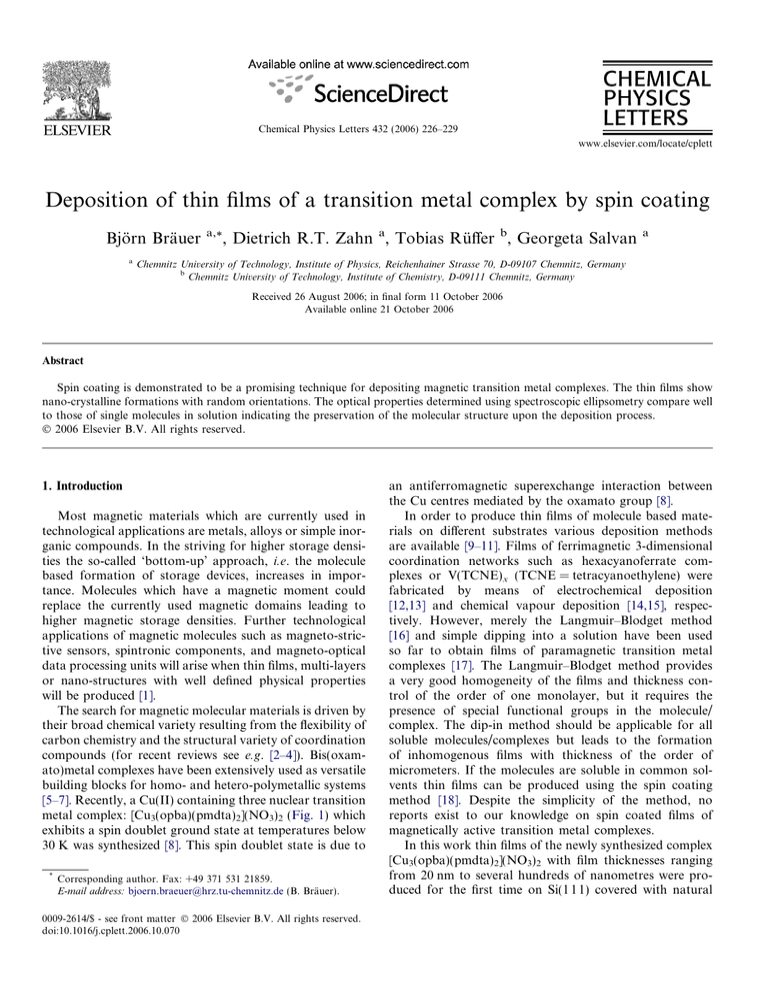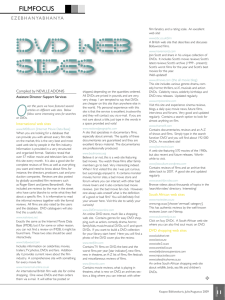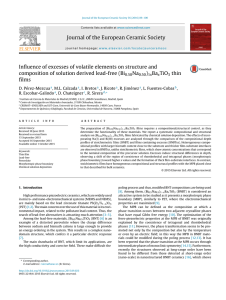
Chemical Physics Letters 432 (2006) 226–229
www.elsevier.com/locate/cplett
Deposition of thin films of a transition metal complex by spin coating
Björn Bräuer
a
a,*
, Dietrich R.T. Zahn a, Tobias Rüffer b, Georgeta Salvan
a
Chemnitz University of Technology, Institute of Physics, Reichenhainer Strasse 70, D-09107 Chemnitz, Germany
b
Chemnitz University of Technology, Institute of Chemistry, D-09111 Chemnitz, Germany
Received 26 August 2006; in final form 11 October 2006
Available online 21 October 2006
Abstract
Spin coating is demonstrated to be a promising technique for depositing magnetic transition metal complexes. The thin films show
nano-crystalline formations with random orientations. The optical properties determined using spectroscopic ellipsometry compare well
to those of single molecules in solution indicating the preservation of the molecular structure upon the deposition process.
2006 Elsevier B.V. All rights reserved.
1. Introduction
Most magnetic materials which are currently used in
technological applications are metals, alloys or simple inorganic compounds. In the striving for higher storage densities the so-called ‘bottom-up’ approach, i.e. the molecule
based formation of storage devices, increases in importance. Molecules which have a magnetic moment could
replace the currently used magnetic domains leading to
higher magnetic storage densities. Further technological
applications of magnetic molecules such as magneto-strictive sensors, spintronic components, and magneto-optical
data processing units will arise when thin films, multi-layers
or nano-structures with well defined physical properties
will be produced [1].
The search for magnetic molecular materials is driven by
their broad chemical variety resulting from the flexibility of
carbon chemistry and the structural variety of coordination
compounds (for recent reviews see e.g. [2–4]). Bis(oxamato)metal complexes have been extensively used as versatile
building blocks for homo- and hetero-polymetallic systems
[5–7]. Recently, a Cu(II) containing three nuclear transition
metal complex: [Cu3(opba)(pmdta)2](NO3)2 (Fig. 1) which
exhibits a spin doublet ground state at temperatures below
30 K was synthesized [8]. This spin doublet state is due to
*
Corresponding author. Fax: +49 371 531 21859.
E-mail address: bjoern.braeuer@hrz.tu-chemnitz.de (B. Bräuer).
0009-2614/$ - see front matter 2006 Elsevier B.V. All rights reserved.
doi:10.1016/j.cplett.2006.10.070
an antiferromagnetic superexchange interaction between
the Cu centres mediated by the oxamato group [8].
In order to produce thin films of molecule based materials on different substrates various deposition methods
are available [9–11]. Films of ferrimagnetic 3-dimensional
coordination networks such as hexacyanoferrate complexes or V(TCNE)x (TCNE = tetracyanoethylene) were
fabricated by means of electrochemical deposition
[12,13] and chemical vapour deposition [14,15], respectively. However, merely the Langmuir–Blodget method
[16] and simple dipping into a solution have been used
so far to obtain films of paramagnetic transition metal
complexes [17]. The Langmuir–Blodget method provides
a very good homogeneity of the films and thickness control of the order of one monolayer, but it requires the
presence of special functional groups in the molecule/
complex. The dip-in method should be applicable for all
soluble molecules/complexes but leads to the formation
of inhomogenous films with thickness of the order of
micrometers. If the molecules are soluble in common solvents thin films can be produced using the spin coating
method [18]. Despite the simplicity of the method, no
reports exist to our knowledge on spin coated films of
magnetically active transition metal complexes.
In this work thin films of the newly synthesized complex
[Cu3(opba)(pmdta)2](NO3)2 with film thicknesses ranging
from 20 nm to several hundreds of nanometres were produced for the first time on Si(1 1 1) covered with natural
B. Bräuer et al. / Chemical Physics Letters 432 (2006) 226–229
2+
O
N
N Cu
N
O
N
N
Cu
O
O
N
Cu N
N
O
O
2 NO3-
Fig.
1. Lewis
formula
of
[Cu3(opba)(pmdta)2](NO3)2
with
pmdta = 1,1,4,7,7-pentamethyldiethylenetriamine and opba = orthophenylenebis(oxamato). Note that the terminal ligands span a 3-dimensional geometry with a stretched trigonal bipyramidal coordination
geometry.
SiO2 using spin coating. We show that such films have a
better homogeneity compared to films produced by simple
dipping of the substrates into a solution containing the
complex followed by drying under atmospheric conditions
after extraction from the solution. By comparing the optical properties of the films with those of the diluted complex
in solution we deduce that the molecular structure of the
complex remains unaffected by the deposition process.
Moreover, knowledge of the optical properties of films is
of prime importance for understanding, e.g. their magneto-optical properties.
2. Experimental
In order to synthesize [Cu3(opba)(pmdta)2](NO3)2
(Fig. 1) [Cu(pmdta)](NO3)2 was coordinated on (nBu4N)2[Cu(opba)] where nBu = nbutyl. The synthesis path for
[Cu3(opba)(pmdta)2](NO3)2 is described in detail elsewhere
[8]. The purity of the powder was proved using elemental
analysis.
The films were deposited on Si wafers (8 · 8 mm) covered with 2 nm thick natural SiO2 using spin coating. For
this purpose [Cu3(opba)(pmdta)2](NO3)2 was dissolved in
acetonitrile. The film thickness was controlled by variation
of two parameters: the concentration and the rotation
speed. The values are given in Table 1 for the case of two
samples discussed in this work. The error bars in the third
column were obtained from several experiments with the
respective concentration and rotation speed. For comparison a film of approximately 100 nm was spin coated on
quartz substrate.
Spectroscopic ellipsometry investigations were performed using a variable angle spectroscopic ellipsometer
(VASE, Woollam Co.). Absorption measurements in
solution were performed using 4 · 105 M solution of
[Cu3(opba)(pmdta)2](NO3)2 in CH2Cl2. The measurements
on solution and on the film on quartz were acquired with a
227
Carl Zeiss Specord M40 spectrometer. Polarized optical
microscopy investigations were performed with a Zeiss
Axioscop 40 device. The Raman spectra were recorded in
a backscattering scattering geometry using a Dilor XY
800 spectrometer equipped with a Peltier-element cooled
CCD detector.
3. Results and discussion
In order to optimize the homogeneity of spin coated
films with respect to the uniformity in film thickness over
the whole sample several solvents were employed. The most
important criteria are good solubility and spreading of
the solution on the sample surface. [Cu3(opba)(pmdta)2](NO3)2 exhibits high solubility in dimethylsulfoxide, N,Ndimethylformamide and acetonitrile. The latter is the most
suited solvent since it has the best spreading properties on
the Si/SiO2 substrate among the mentioned solvents and a
comparatively low boiling point (82 C).
Different rotation speeds were used for the preparation
of the films on Si/SiO2 ranging from 60 rotations per minute (rpm) up to 1000 rpm in order to vary their thickness.
Polarisation microscopy images measured in reflection
are displayed in Fig. 2 for the films produced by dipping
the substrate into a solution and using spin coating with
1000 rpm rotation speed. Fig. 2a,c were taken in nonpolarized, while Fig. 2b,d were obtained in polarized mode.
For the films produced by dipping into a solution the
formation of preferentially ordered needle shaped crystals
with lengths of the order of 200 lm was observed
(Fig. 2a). The crystalline nature of these structures is confirmed by their appearance in the polarised microscope
mode (Fig. 2b) [19]. The image recorded in non-polarised
Table 1
Layer thicknesses of spin coated films determined using spectroscopic
ellipsometry
Concentration (mg/ml)
Rotation speed (rpm)
Layer thickness (nm)
3
5
1000
600
30 ± 10
100 ± 20
Fig. 2. Polarization microscopy images of [Cu3(opba)(pmdta)2](NO3)2 on
Si(1 1 1)/SiO2 using unpolarized (a)/(c) and polarized light (b)/(d), respectively, for a film produced by dipping into a solution (a)/(b) and a sample
spin coated with 1000 rpm (c)/(d).
-5
solution in CH2Cl2 (10 M)
thin film on quartz
1.7
0.2
n
k
1.6
0.1
1.5
0.0
1
2
4
5
Fig. 4. Comparison between the absorption spectra of [Cu3(opba)(pmdta)2](NO3)2 in CH2Cl2 solution and of a thin film of the same complex on
quartz (top). The spectra were normalized to the height of the peak at
4.23 eV. In the lower part the refractive index and the extinction coefficient
for the complex as derived from the SE spectra of the thin film
[Cu3(opba)(pmdta)2](NO3)2 on Si(1 1 1)/SiO2 is plotted.
Intensity / a. u.
quartz, nor in the k spectrum of the film on Si. The latter
two are very similar, reflecting a similar structure of the
films deposited on the two substrates. This is not surprising
considering that the Si substrates are covered with natural
oxide.
As a general trend we observe a red shift of the most
intense absorption bands when going from the diluted solution to the solid state. The first absorption band, which is
assigned to a d–d transition of Cu(II), shifts from 1.9 to
1.8 eV. The bands stemming from the charge transfer transitions at 3.5 to 4.5 eV show a red shift as well. A similar
red shift of the optical absorption bands was reported for
many molecules. For example, in the case of tris(8hydroxyquinoline)-aluminum(III) (Alq3) [22], the red shift
occurs as a result of the molecular interaction in the condensed state according to Gordan et al. [23].
/6
powder
spin
coated film
1400
Fig. 3. Scanning electron microscopy image of [Cu3(opba)(pmdta)2](NO3)2 on Si(1 1 1)/SiO2 shows nano-crystalline order.
3
E /eV
Extinction coefficient - k
mode from the sample coated at high rotation speed
(Fig. 2c) clearly shows the alternation of bright and dark
areas with size in the order of only a few microns. The
absence of bright regions in the image Fig. 2d recorded
using polarized light reflects that only a few areas have a
crystalline nature at the micrometer scale given by the resolution of the polarisation microscope. It must be noted,
however, that on the nanometer scale small crystals without a preferential orientation were observed using scanning
electron microscopy (Fig. 3).
The thickness of the films was determined by means of
spectroscopic ellipsometry (SE). In addition, SE delivers
valuable information concerning the absorption behaviour
of the molecules on the substrate [20]. The film thickness
was determined using a Cauchy model in the spectral range
from 0.8 to 1.0 eV. The obtained values are given in Table
1. The slight absorption in this range was taken into
account using a k-value of 0.1. The dielectric function in
the range from 0.8 to 5 eV was evaluated considering the
layers as isotropic. In a first step a point-by-point fit of
the measured ellipsometric angles W and D was performed,
i.e. fitting the calcutated ellipsometric parameters to the
experimental data at each wavelength separately. In the
next step a sum of Gaussian oscillators was used to simulate the line shape of the imaginary part of the dielectric
function e2, while the real part of the dielectric function
e1 is generated according to the Kramers–Kronig relation.
The extinction coefficient k is calculated from the complex
dielectric function according to (n + ik)2 = e1 + ie2, where n
is the refractive index of the material. Fig. 4 shows k compared to the absorption spectrum recorded for a film on
quartz with a thickness of approximately 100 nm and to
that of [Cu3(opba)(pmdta)2](NO3)2 diluted in a CH2Cl2
solution (105 M).
The fine structure of the main absorption band in the
solution spectrum occurs as a result of vibrational transitions which accompany the electronic transitions [21].
The intermolecular interactions in the solid state broaden
the vibronic fine structure and consequently they are neither resolved in the absorption spectrum of the film on
Absorption / a. u.
B. Bräuer et al. / Chemical Physics Letters 432 (2006) 226–229
Refractive index - n
228
1500
Raman shift / cm-1
1600
Fig. 5. Comparison between the Raman spectra measured on powder
(upper spectrum) and on a thin spin coated film on Si(1 1 1)/SiO2 (lower
spectrum). The spectra are normalised to the height of the mode at
1580 cm1.
B. Bräuer et al. / Chemical Physics Letters 432 (2006) 226–229
When the broadening and the red shift are taken into
account the line shape of the absorption spectra of solution and thin films on quartz appear to be quite similar.
This leads to the conclusion that the molecular structure
is preserved during the deposition process. The finding
is supported by the results of Raman spectroscopy measurements on powder and thin films. Fig. 5 displays the
Raman spectra of powder and of a thin spin coated film
in the region of C–H deformation and C–C, C@O, and
C–N stretching vibrations where the signal is most
intense. A detailed assignment of the vibrational bands
will be provided in a forthcoming paper. The spectra were
recorded at room temperature with the 457 nm (2.7 eV)
emission line of an Ar+ laser which lies in the absorption
onset of the charge transfer band. The incident laser
power was 5 mW and the laser spot size on the sample
was approximately 300 lm in diameter. The resulting
power density was low enough to avoid damage to the
samples. A close look at the two spectra shows that the
band positions as well as their relative intensities are
the same, a clear proof for the preservation of the molecular structure.
4. Summary
The spin coating was demonstrated to be a promising
deposition technique for magnetic transition metal complexes. The spin coated thin films of [Cu3(opba)(pmdta)2](NO3)2 show the formation of a nano-crystalline
phase without preferential orientation leading to an isotropic optical response. The good correlation between the
absorption measurements on quartz and the transmission
investigations in solution reinforces the results on the optical isotropy of the films.
In general, most of the synthesized transition metal complexes cannot be sublimed. This fact might restrict their
application potential in devices consisting of thin films
where a very precise control of the film thickness is
required. However, a lot of these compounds are soluble
in common solvents and should preserve their molecular
structure during the deposition using spin coating. We have
shown for the case of [Cu3(opba)(pmdta)2](NO3)2 that a
good control over the thickness and the homogeneity can
be achieved by this method.
The structure of Bis(oxamato)metal complexes allows
several tools for tuning their physical properties: by varying the central N,N 0 -bridge, the terminal ligands, and the
transition metals. Taking advantage of the high flexibility
of these compounds the film quality can also be adjusted
eventually providing
applications.
229
access
towards
technological
Acknowledgements
The authors thankfully acknowledge the Fonds of
Chemical Industry for funding. We thank Dr. Matthias
Lehmann and Michael Jahr for the polarization microscopy investigations and Dr. Steffen Schulze for the scanning electron microscopy investigations.
References
[1]
[2]
[3]
[4]
[5]
[6]
[7]
[8]
[9]
[10]
[11]
[12]
[13]
[14]
[15]
[16]
[17]
[18]
[19]
[20]
[21]
[22]
[23]
J.S. Miller, A.J. Epstein, MRS Bulletin (November) (2000) 21.
P. Day, C.R. Acad. Sci. Paris, Chimie, Chemistry 4 (2001) 75.
D. Gatteschi, R. Sessoli, J. Magn. Magn. Mater. 272-276 (2004) 1030.
E. Coronado, P. Day, Chem. Rev. 104 (2004) 5419.
O. Kahn, Molecular Magnetism 1 Aufl, VCH Weinheim, 1993.
O. Kahn, Magnetism: a supramolecular functionNATO ASI Series C,
vol. 484, Kluwer (Academic Publishers), Dordrecht, The Netherlands,
1996, p. 531.
A. Aukauloo, X. Ottenwaelder, R. Ruiz, Y. Journaux, Y. Pei, E.
Revière, M. Munoz, Eur. J. Inorg. Chem. (2000) 951.
T. Rüffer, B. Bräuer, A. Powell, I. Hewitt, G. Salvan, Eur. J. Inorg.
Chem., submitted for publication.
J. Fraxedas, Adv. Mater. 14 (22) (2002) 1603.
L. Valade, D. de Caro, M. Basso-Bert, I. Malfant, C. Faulmann, B.
Garreau de Bonneval, J.P. Legros, Coord. Chem. Rev. 249 (2005)
1986.
L. Valade, D. de Caro, I. Malfant, in: L. Ouahab, E.B. Yagubskii
(Eds.), Organic conductors, superconductors and magnets: from
synthesis to molecular electronics, NATO Science Series II Mathematics Physics and Chemistry, vol. 139, Kluwer Academic and
NATO Scientific Affairs Division, Dordrecht/Boston/London, 2004,
p. 241.
M. Mizuno, S. Ohkoshi, K. Hashimoto, Adv. Mater. 12 (24) (2000)
1955.
P.H. Zhou, D.S. Xue, J. Appl. Phys. 96 (1) (2004) 610.
K.I. Pokhodnya, A.J. Epstein, J.S. Miller, Adv. Mater. 12 (2000) 410.
P. Cassoux, D. de Varo, L. Valade, H. Casellas, S. Roques, J.-P.
Legros, Synthetic Met. 133-134 (2003) 659.
C. Lafuente, C. Mingotaud, P. Delhaes, Chem. Phys. Lett. 302 (1999)
523.
K. Ueda, G. Tanaka, T. Suzuki, R. Kita, S. Kokado, Polyedron 24
(2005) 2533.
R.W. Miles, K.M. Hynes, I. Forbes, Prog. Crystal Growth Charact
Mater 51 (2005) 1.
M. Lehmann, C. Köhn, H. Meier, S. Renker, A. Oehlhof, J. Mater.
Chem. 16 (2006) 441.
B. Johs, C. Herzinger, Guide to Using WVASE32, J A Woollam Co.,
Inc., Lincoln, NE, 1995.
R. Scholz, A. Yu. Kobitski, D.R.T. Zahn, M. Schreiber, Phys. Rev. B
72 (2005) 245208.
M. Brinkmann, G. Gadret, M. Muccini, C. Taliani, M. Masciocchi,
A. Sironi, J. Am. Chem. Soc. 122 (2000) 5147.
O.D. Gordan, C. Himcinschi, D.R.T. Zahn, C. Cobet, N. Esser, W.
Braun, Appl. Phys. Lett. 88 (2006) 141913.







